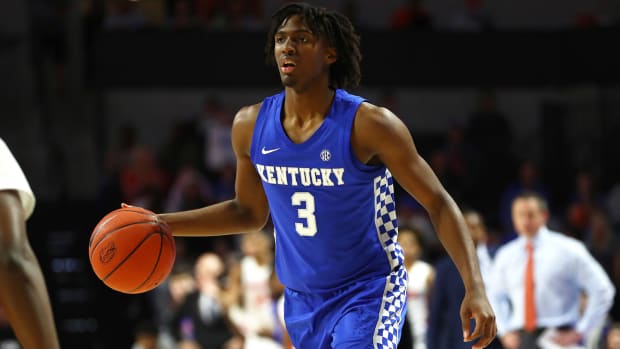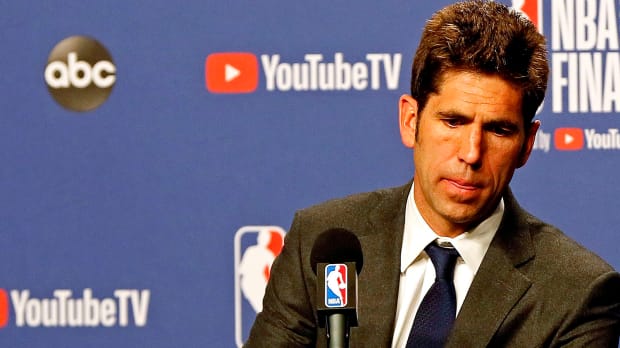As the pandemic pushed back the NBA draft, prospects like former Stanford guard Tyrell Terry have used the extra time to boost their stock by staying in the gym and participating in Zoom calls with NBA teams.
Feel-good stories have been hard to find in a year where so much has gone wrong, and basketball has taken a backseat. On March 11, Tyrell Terry had little reason to think he’d be writing one. That night, Stanford’s NCAA tournament hopes were dashed with a loss to rival Cal at the Pac-12 tourney, a key game played to minimal fanfare and scant observers in the stands. “We came into the locker room devastated,” Terry says. “Then we find out that they cancelled the NBA season. So of course, we figure it’s looking bad for the NCAA to continue as well.”
As the threat of COVID-19 became widely apparent and the cancellation of college basketball’s postseason followed, Terry faced a decision he hadn’t fully considered. After entering the season off the NBA’s radar, he had an opportunity to turn pro after a strong freshman season. Stanford had never before produced a one-and-done prospect. His early feedback from teams was positive, and Terry settled on staying in the draft, feeling comfortable at the prospect of earning a guaranteed contract.
He began training in April with one major goal: packing as much muscle as possible onto a frame that weighed just 155 pounds at the end of Stanford’s season. At that point, nobody knew the draft would be rescheduled for November, as opposed to June. But the additional time in the gym, mixed with a healthy dose of Zoom calls (Terry estimates he’s held nearly 40 separate meetings with NBA teams) has helped his case, leading to increased interest from teams picking all over the first round.
“I knew I needed to add strength and weight, and I didn’t really see results right away, which was a little bit discouraging,” Terry says. “But we didn’t know this was going to last six months. So we put in a program, between weightlifting, on-court, nutrition, and also mental health, meditation. When it was announced that we’d have more time, I just stuck with the routine I was in. That extra time has really allowed me to see more results.”
When the NBA conducted official combine testing last week, Terry stepped on the scale at 170 pounds, a far cry from his playing weight. Surprisingly, he’d also grown an inch, standing 6’3” in shoes. Team representatives have come away impressed with him in interviews, and multiple league sources hypothesize he’ll be drafted somewhere in the teens. Terry took sporadic trips home to Minneapolis over the summer, but has been training full-time in Indianapolis since August. And he’s on the verge of making good on the longest job application process any college freshman will ever face.
“It’s been difficult,” Terry admits. “The anxiousness, the longevity of this time, normally prospects don’t have to go through this type of wait. And so I think the biggest thing for me was having the patience and developing good habits to keep me going through this long period. To eventually get those results and continuing to work my butt off has made this easier for me.”
Terry plans to travel home for a small gathering with family and friends on draft night. The NBA will broadcast the draft from afar and usher in rookies digitally. “I’m not exactly sure what the attire is supposed to be, but it shouldn’t be a problem,” Terry says.
His tailor may need to go one size up.
SI's NBA offseason coverage

- Jeremy Woo’s latest Mock Draft
- Can the NBA pull off a December return?
- Assessing the NBA coaching carousel
- Tom Crean on Anthony Edwards
- What should the Warriors do with No. 2?
- Why LaMelo is the draft’s swing factor
- What you need to know about the Virtual Combine
Prospect close-up: Tyrell Terry
Watch guards like Seth Curry and Landry Shamet make positive impacts in the playoffs and you can see a future role for Terry, who has work to do to become a truly elite shooter but has the right skill set for the job long-term. His compact release and feel for moving the ball around the perimeter made him dangerous right away at Stanford, and he finished well around the rim, particularly for a guy his size. Terry has to improve playing off the bounce and continue adding strength, but it’s hard to discount his smarts and shooting potential. His size will likely be an obstacle on defense, but he has plenty of other things working in his favor. Though he may need more time to develop and get stronger, Terry has a clear path to becoming a high-end role player.
Read more in SI’s latest Big Board

The reasoning behind all the Warriors rumors
Whether you’re a NBA reddit diehard or just like to search “NBA draft” every few days out of boredom, you may have noticed that Golden State, which holds the No. 2 pick, has been linked to almost every single player in the lottery. That is not an accident. The Warriors have nothing to lose and everything to gain from being as obtuse and confusing as possible. The less certain everyone else is about what they’ll do, the easier it is to leverage the pick in a trade. With Minnesota (No. 1) and Charlotte (No. 3) also keeping open the possibility of moving back, the Warriors essentially destabilize those teams’ negotiations with any doubt they can generate through leaking information. What they can’t afford to do right now is telegraph which players they don’t like, or the idea that they don’t think the options are strong (even if that’s the truth).
My present feel for that situation is as follows: if Golden State keeps the pick, they’ll almost surely walk away with Anthony Edwards or James Wiseman, depending on who Minnesota takes (and my gut feeling has always been that the Wolves end up with Edwards). If they find a way to move back into the 5-8 range, the other names (Obi Toppin, Tyrese Haliburton, Deni Avdija) come into play. If I had to place a bet, it would be that the Warriors stay put and take Wiseman. And if we’re assuming Edwards and Wiseman are off the board, that of course puts Charlotte in a fascinating spot at No. 3. But I digress.